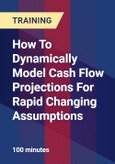This Microsoft Excel training will help attendees to understand how to build a dynamic Cash Flow forecasting model in Excel. Also attendees will learn how to design and construct the classic cash flow template and implementation of Excel spinners for dynamic display and calculation of changing assumptions.
Knowing when money is coming in or going out, how much is being exchanged and communicating this accurately is often the deciding factor when it comes to making key business decisions.
Whether your organization is in growth mode, status quo, losing ground or survival mode, cash flow forecasting is critical to your success. Are you confident in your current forecasting strategy? This course can help you but is also ideal for the staff accountant who could use a clear, roadmap for cash flow forecasting.
Inadequate cash flow forecasting management is one of the leading causes of business failure. Many organizations only begin to focus on cash flow management during bad times. Having a good system in place to manage cash flow during good times contributes to an organization's success, allowing it to take advantage of opportunities for growth and providing a competitive edge.
Excel has tools that can give cash flow projections a certain sizzle when presented to bank lending officers and potential investors. We conclude this course illustrating the best way to communicate competent cash flow forecasting to a banker or board of directors. You will leave this course with the skill to construct a classic cash flow model using the latest Excel techniques displaying a special degree of financial professionalism.
Why Should You Attend:
Cash is King. Cash flow forecasting is one of the most critical aspects of running a business of any size. This is also a key skill every accountant, budget manager and financial analyst must possess. You will leave this webinar with the knowledge and skills needed to construct a classic cash flow template using state-of-the-art technology.Knowing when money is coming in or going out, how much is being exchanged and communicating this accurately is often the deciding factor when it comes to making key business decisions.
Whether your organization is in growth mode, status quo, losing ground or survival mode, cash flow forecasting is critical to your success. Are you confident in your current forecasting strategy? This course can help you but is also ideal for the staff accountant who could use a clear, roadmap for cash flow forecasting.
Inadequate cash flow forecasting management is one of the leading causes of business failure. Many organizations only begin to focus on cash flow management during bad times. Having a good system in place to manage cash flow during good times contributes to an organization's success, allowing it to take advantage of opportunities for growth and providing a competitive edge.
Excel has tools that can give cash flow projections a certain sizzle when presented to bank lending officers and potential investors. We conclude this course illustrating the best way to communicate competent cash flow forecasting to a banker or board of directors. You will leave this course with the skill to construct a classic cash flow model using the latest Excel techniques displaying a special degree of financial professionalism.
Learning Objectives:
- Build a simple yet effective Cash Flow forecasting model in Excel
- Understand, design and construct the classic cash flow template
- Follow the ebb and flow of cash flow in either a service or retail business
- Cutting-edge techniques for predicting cash excess and shortfalls
- How to implement Excel spinners for dynamic display and calculation of changing assumptions
- Effectively chart cash flow projects to highlight times of needed borrowing vs. periods of investment of excess funds
- Accrual vs Cash accounting and how to establish the relationship of receipts and disbursements as related to appropriate timing
- How to establish and improve banking relationships
- Key takeaway - a classic Excel cash flow template for every situation
Areas Covered in the Webinar:
Understanding the Statement of Cash Flows
- Three Primary Sources and Uses of Cash
- Cash Flow Planning: Cash Flow from Operations v. Free Cash Flow
- Overview of the Corporate Treasury Function
Accrual vs. Cash Accounting: Cash Flow Timing
- Understanding the Business Operating Cycle and Bridge Loans or “Gap” Financing
- Service Industry v. Retail and Manufacturing
- Sales, Receivables, Collections and Cash Flow Timing
- Inventory, Payables, Disbursements and Cash Flow Timing
- Expenses v. Cash Flow
Constructing a Basic Excel Cash Flow Template
- Overview: Assumptions, Receipts, Disbursements, Net, Beginning Balance, Ending Balance
- Connecting the Sales Forecast to Bad Debt and Collections and Cash Flow Timing via Cell References
- Connecting the Expenses Forecast to Disbursements and Cash Flow Timing via Cell References
- Incorporating Timing into Assumptions via Cell References
- Simple Necessary Formulas
Constructing Excel Spinners for Professional Polish
- Form Control and Excel Spin Button
- Cell References to Tie the Spin Button to the Assumptions for the Cash Flow Statement
Communicating and Solving Forecasted Problems - Banker Communications
- Charting Techniques for Easy Communication
- Dealing with Seasonality Timings
- Forecasting Borrowing Needs and Repayment
- Integrating Spinners and Charts for a Professional Presentation
Who Will Benefit:
- Accountant
- Budget Manager
- Financial Analyst
- Auditor
- Business Owner
- Bookkeeper
- Controller
- CFO
- Division Director
- General Manager
Speaker
Joe WeilCourse Provider

Joe Weil,









